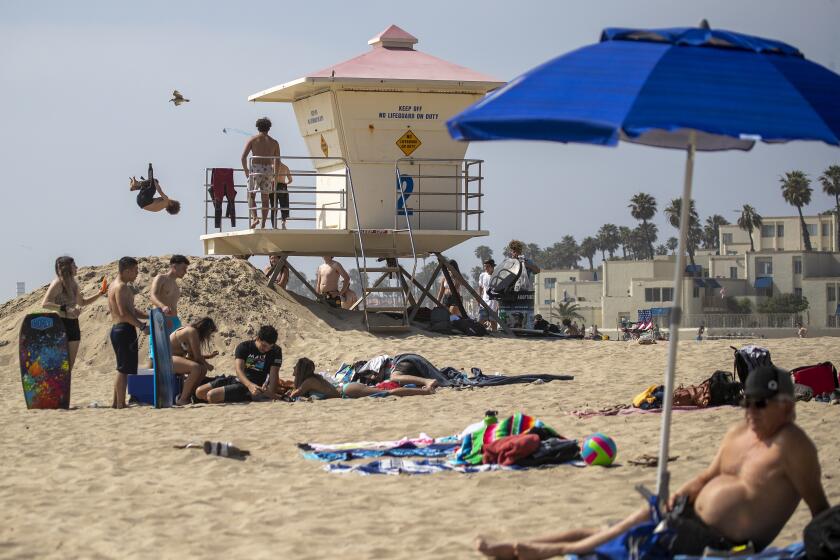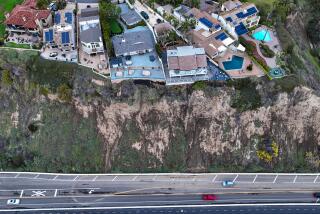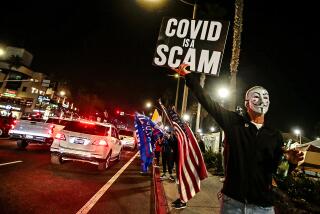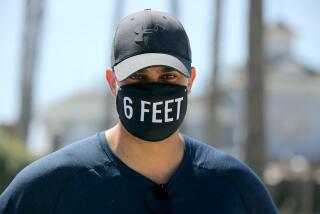In beach closure, some in Orange County see overbearing hand of the ‘nanny state’
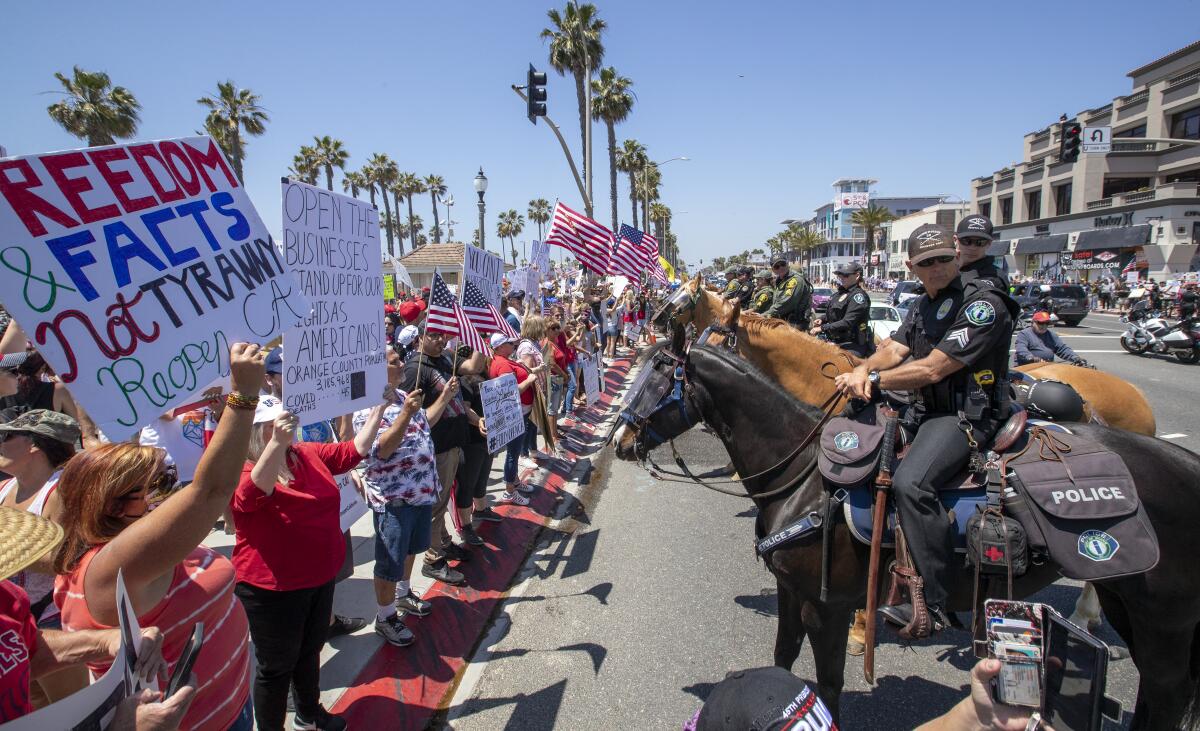
- Share via
When he called last week for the local beachfront to remain open amid the coronavirus crisis, the Newport Beach mayor argued that his city’s infection rate was lower than any of its beach-city counterparts in L.A. County, where the sands have been off-limits from Malibu to Long Beach.
Despite a scolding from the governor chagrined by news photos that seemed to show unsafe clusters of beachgoers the weekend before, many of who had driven in from L.A., Newport Beach leaders voted 5-2 to keep the beach open. “We can truly trust the vast majority of people to do the right thing,” said Mayor Will O’Neill.
Then Gov. Gavin Newsom, a Democrat, ordered beaches closed in Newport Beach and the rest of Orange County. It has unleashed a torrent of criticism from elected officials, in a county that is no longer a conservative bastion but still tilts heavily Republican along the affluent coastal cities.
“Without speaking to a single local official in Newport Beach, Governor Newsom has put politics over data, and substituted his will for our judgment from 428 miles away in Sacramento,” O’Neill tweeted Thursday.
Said Sheriff Don Barnes: “The governor’s decision to single out Orange County by closing our beaches is wrong and fails to recognize the sacrifices made by our 3 million residents.”
Supervisor Don Wagner said news photos had given a misleading impression of densely packed weekend visitors to Newport Beach who, in reality, mostly adhered to social-distancing rules.
“The telephoto lens distorted what was going on at the beach,” Wagner said. “It is not wise to make policy from Sacramento based on a couple of photographs out of a local paper.”
In Huntington Beach, the city north of Newport Beach, protesters gathered Friday to denounce the governor’s action, and the city has announced it will sue the state to keep its beaches open.
The anger over the Sacramento-mandated beach closures comes amid growing unrest in a county known for years as a bastion of “cowboy capitalism,” a political philosophy emphasizing free markets, low taxes and an aversion to big government.
“There’s always been an Orange County-Sacramento friction,” said Fred Smoller, an associate professor of political science at Chapman University. “Particularly in the wealthier cities, they just don’t want liberals or a Democratic legislature telling them what to do.”
Huntington Beach and Dana Point have voted to seek injunctions, and the Orange County sheriff has said he doesn’t plan to arrest beachgoers.
Coupled with that is a resentment of perceived “nanny state” overreach, the idea that “we’re gonna do what’s best for you, whether it’s telling you to wear helmets or not smoke cigarettes,” Smoller said.
Beach city residents are aware, and like to point out, that they live in a travel-poster landscape where others journey many miles just to visit. And for many in Orange County, Smoller added, it “is definitely seen as a reward for hard work and a life of sacrifice and accomplishment.”
Orange County was the birthplace of Richard Nixon and a stronghold of the John Birch Society. It remains the place where a swaggering statue of John Wayne greets visitors at the airport bearing his name, and where a statute of Ronald Reagan waves jovially to strollers on the Balboa Island bay front.

In recent years the political makeup of Orange County has shifted, with slightly more registered Democrats than Republicans, but coastal cities like Newport Beach, Huntington Beach and San Clemente remain red.
Smoller said elected officials like Wagner, O’Neill and Board Supervisor Michelle Steel, who have denounced the governor’s beach closure, speak for “the old Orange County of rugged individualism and making your own way,” and added: “I think they speak for a fraction of Orange County that is diminishing in size.”
Orange County officials can (and do) point to relatively low per-capita infection rates to suggest that they know what they’re doing, amid a health crises that has prompted unprecedented government intervention worldwide.
Orange County, by Friday’s count, had 2,393 coronavirus cases, with 45 deaths, in a population of about 3 million. The death rate per 100,000 is 1.4.
By contrast, Los Angeles County had 23,233 cases, with 1,119 deaths, in a population of 10 million. The death rate per 100,000 is 11.1. Adjacent Riverside County, with a smaller population than Orange, had more than three times as many COVID-19 deaths.
In Newport Beach, which has about seven miles of beach, city officials said they received more than 1,000 emails on the question of beach access, with the majority in favor of keeping the beach open.
In arguing to keep the beach open, O’Neill, the mayor, pointed to the harmful effects of social isolation, including obesity, anxiety, depression and cognitive decline, and said the crisis had caused “an incredible spike” in calls to suicide hotlines.
He said Hoag Hospital, which has a campus in Newport Beach and another in Irvine, had not seen more than 25 coronavirus cases between its Newport Beach and Irvine campuses at any one time. He said that once the brakes were put on international travel to the United States, the virus’ spread seems to have been curtailed in Newport, which sees a substantial number of visitors from abroad.
Newport Beach councilman Jeff Herdman was one of two votes to keep the city’s beaches closed. He said that while the majority of the emails were in favor of open beaches, many seemed to be “from kids who were out of school and want to go surfing.”
“Usually in situations like this you don’t hear from people who want the beaches closed, because they just assume their city council will do the right thing in terms of protecting them,” Herdman said. “And what happened instead was that ideology entered into the decision-making process.”
The other vote to close the Newport beachfront was Joy Brenner, who represents the Corona del Mar segment of the city and describes herself as a moderate conservative. Brenner said the city council was “playing politics in a pandemic,” and that many Newport Beach voters, though conservative Republicans, support the governor’s stance. “They say, ‘I don’t like Newsom but he’s doing a good job,’” she said.
Brenner said that many Newport Beach residents who are sheltering in place “are dramatically impacted by the people who are parking in front of their homes and unloading their cars and hanging out on the sidewalk and walking down the sidewalk to get to the beach, so they don’t feel lie they can leave their home.”
She added: “I hate the idea that Newport Beach is portrayed as this elitist community that doesn’t want visitors. [Residents] are friendly people. They know when they live on the beachfront they will have visitors. But this is a different situation, and they’re afraid.”
She said she worried about the danger to lifeguards. “There’s no social distancing when you’re doing a lifeguard rescue,” Brenner said. “We’re putting our lifeguards in danger. The trash cans are just overflowing, so we’re putting our trash-collection personnel in danger. So we’re creating another biohazard.”
State Sen. John Moorlach (R-Costa Mesa), whose district includes Newport Beach and Huntington Beach, said: “You’ve got to trust the citizenry.” Asked why Orange County has relatively low coronavirus numbers compared to L.A., Moorlach noted that Los Angeles has more public transportation.
“L.A. and New York, they’re dense, they have public transit. That might be one of the major factors,” Moorlach said. “In Orange County we chose to build lanes, not trains.”
Moorlach said he has advocated for balance and a more open economy. “Treat us like you trust us,” he said. “We’ll follow proper protocols, but let us work.”
“If you are vulnerable, then you ought to stay in place,” Moorlach added. “If not, you ought to understand you’re taking a calculated risk. I take a risk every time I drive, but I’m fully cognizant of it. So I put on my seat belt.”
Fueling some of the discontent in Orange County: inconsistent policies among the beach cities. The northernmost beach city is Seal Beach, a small city with a population of 24,000, which has kept its one mile of beachfront closed during the pandemic. Just to the south, however, Huntington Beach had been open until the governor closed it.
“People say, ‘Huntington Beach has decided to have the beach open, well, why can’t we?’” said Seal Beach mayor pro tem Joe Kalmick said. “No matter how reasonable you try to make your answer, they don’t want to hear that.”
He said that in comparison to their Los Angeles counterparts, Orange County political leaders have not issued firm directives. “They have not come out with decisions — you will open or you will close,” Kalmick said. “It’s, ‘We will let the cities decide,’ and that leaves the door open.”
More to Read
Sign up for Essential California
The most important California stories and recommendations in your inbox every morning.
You may occasionally receive promotional content from the Los Angeles Times.
